
Ris_DSP / AD_DSP_selection_guide
.pdf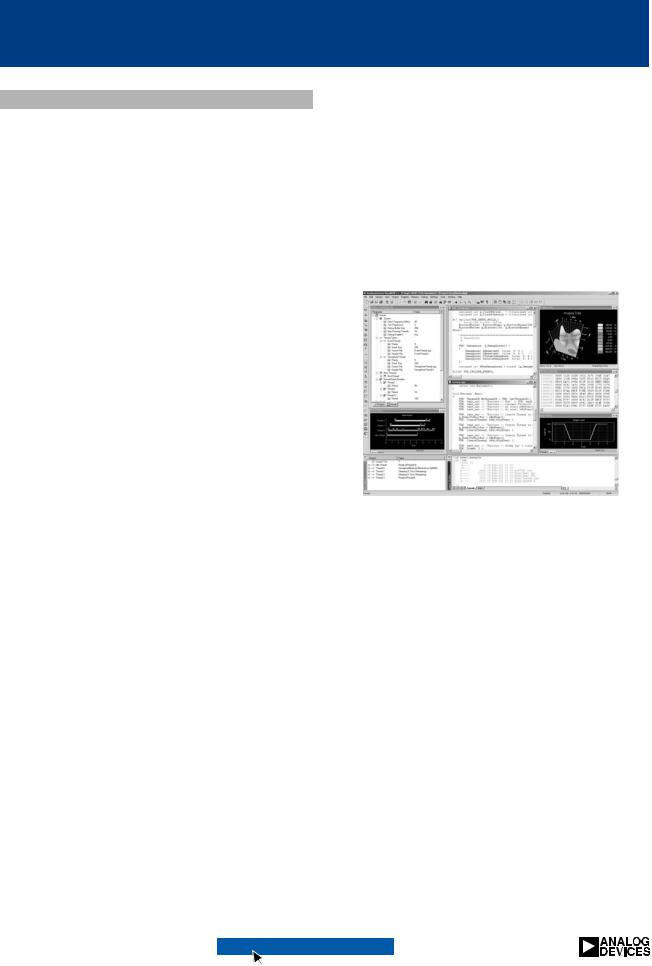
VisualDSP++
Integrated Development Environment
Features
Integrated Development and Debugger
Environment
•Develop within a single interface (IDE/debugger)
•Profile and trace instruction execution of C/C++ and assembly programs (simulator only)
•Set watchpoints (conditional breakpoints) on processor registers and stacks, as well as program and data memory including:
–Statistical profiling
–MP (multiprocessing)
–Graphical plotting
•Define all project and tool configurations through property page dialog boxes
•Set project-wide or individual file settings for debug or release mode project builds
•Create source files using an integrated, fullfeatured editor with syntax highlighting, OLE drag and drop, and bookmarks
VisualDSP++ Kernel (VDK)
•Scheduling and resource management
•Supports threads, events, semaphores, critical and unscheduled regions
Code Generation Key Features
•Develop applications using an optimizing C/C++ compiler
•Intersperse inline assembly statements within C/C++ source code
•Create executables using a linker that supports multiprocessing, shared memory, and code overlays
•Access numerous math, DSP, and C/C++ runtime library routines
•Create host, link port, and PROM boot images
•Initialize all data and code memory locations using modifiable loader
•Concatenate multiple executables within single PROM image
Overview
VisualDSP++ is an easy-to-use project management environment, comprised of an integrated development environment (IDE) and debugger. VisualDSP++ enables management of projects from start to finish from within a single interface. The project development and debug environments are integrated, allowing movement easily between editing, building, and debugging activities.
VisualDSP++ interface
Platform and Processor Support
VisualDSP++ supports the SHARC® DSP, TigerSHARC® DSP , Blackfin DSP, and the ADSP-218x and ADSP-219x DSP families on Windows® 98, Windows NT, Windows 2000, and Windows XP. Refer to ADI’s web site for specifications and availability.
Flexible Project Management
The IDE provides flexible project management for the development of DSP applications. The IDE includes access to all the activities necessary to create and debug DSP projects. The IDE editor allows the creation or modification of source files or viewing of listing or map files. This powerful editor is part of the IDE and includes multiple language syntax highlighting, OLE drag and drop, bookmarks, and standard editing operations such as undo/redo, find/replace, copy/paste/cut, and go to.
10 DSP Selection Guide |
http://www.analog.com/dsp/tools |
|
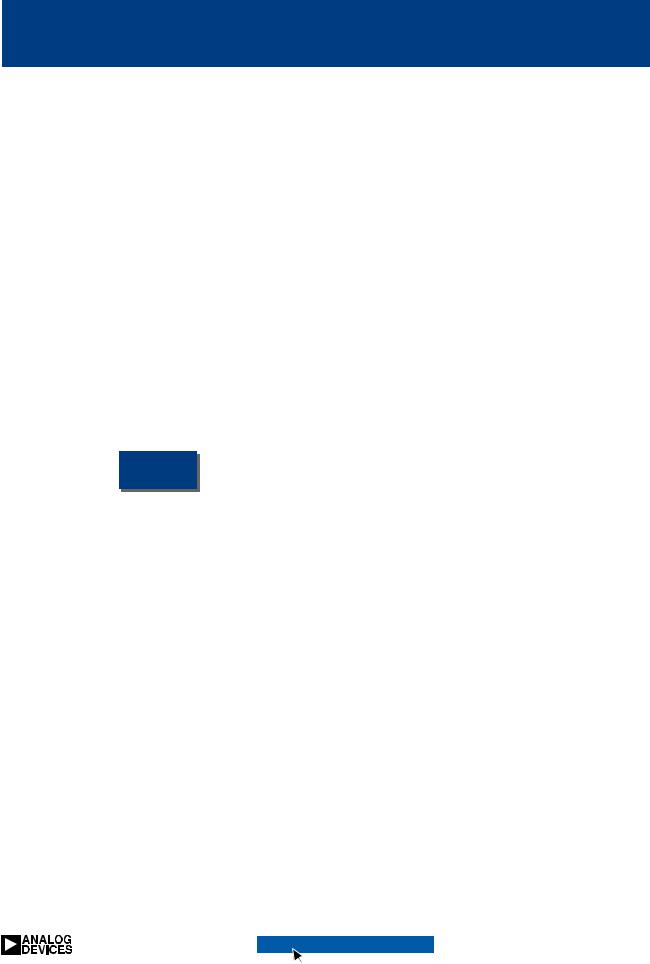
The IDE allows access to the DSP C/C++ compiler, C/C++ runtime library, assembler, linker, loader, and splitter. Specification of options for these tools is made possible through the property page dialogs. Property page dialogs are easy to use and simplify configuring, changing, and managing projects. These options may be defined once and then modified to meet changing development needs. The DSP code generation tools can be accessed from the operating system command line.
Greatly Reduced Debugging Time
The VisualDSP++ debugger has an easy-to-use, common interface to all DSP simulators and emulators available through Analog Devices, Inc. (ADI) and from many third party partners. The debugger has many features that greatly reduce debugging time. C/C++ source can be viewed interspersed with the resulting assembly
VisualDSP++
Development
Environment
|
|
|
|
|
|
|
|
|
|
|
|
|
|
|
|
|
|
|
|
|
|
|
|
|
Software |
|
EZ-KIT Lite™ |
|
Emulator |
|
Third-Party |
||||
|
Simulator |
|
Hardware |
|
Hardware |
|
Hardware |
||||
|
|
|
|
|
|
|
|
|
|
|
|
SHARC DSP, TigerSHARC
DSP, TigerSHARC DSP,
DSP,
ADSP-21xx, Blackfin DSPTM
VisualDSP++ simplifies DSP development via common development environment across all ADI hardware and DSPs
code. Users can profile execution of a range of instructions in a program; set watch points on hardware and software registers, program and data memory; and trace instruction execution and memory accesses. These features enable users to correct coding errors, identify bottlenecks, and examine DSP performance. The custom register option allows developers to select any combination of registers to view in a single window. The debugger, when used with the simulator, can also generate inputs, outputs, and interrupts to simulate real world application conditions. With C++, developers can realize a significant increase in time to market with the ability to efficiently work with
VisualDSP++
complex signal processing data types and take advantage of specialized DSP operations without having to understand the underlying DSP architecture.
VisualDSP++ simplifies DSP development via common development environment across all Analog Devices hardware and DSPs.
VisualDSP++ Kernel
The VisualDSP++ Kernel (VDK) provides state-of-the-art scheduling and resource allocation techniques tailored specifically to address the memory and timing constraints of DSP programming. These techniques enable engineers to use example code more efficiently, eliminating the need to start from the very beginning. The VDK has standard libraries and frameworks with defined APIs that allow easy inclusion of boilerplate, class libraries and value-added IP code.
ActiveX
ActiveX allows new functionality to be added by developers and third parties to VisualDSP++ in the form of “plug-ins” that integrate into the VisualDSP++ environment. Third parties will be able to seamlessly port their software to VisualDSP++’s front-end. Developers will be able to merge tool suites together to improve design, analysis and verification thus they will only need to learn one interface to use ADI third party tools.
Multiprocessing Support
VisualDSP++’s smart multiprocessor (MP) debug support provides a seamless interface to multiple DSPs on the same physical hardware. Users are able to issue parallel step, run, and halt commands to all of the applicable DSPs. The developer can pick and choose individual DSP register or memory sets of interest by pinning those that should be updated between runs, halts and steps. This feature also eliminates screen clutter in multiprocessor debugging.
http://www.analog.com/dsp/tools |
DSP Selection Guide 11 |
|
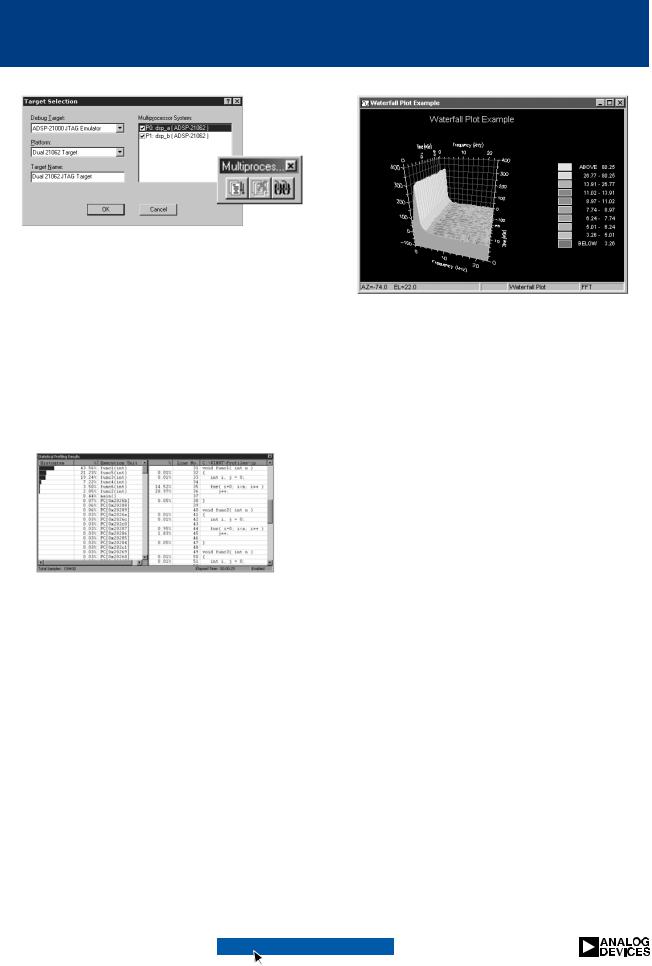
VisualDSP++
VisualDSP++’s multiprocessor dialog box and toolbar
Statistical Profiling
Statistical profiling allows for a more generalized form of profiling that JTAG emulator debug targets can take advantage of. The debugger has the ability to unintrusively random sample the target processors PC and then present the user with a graphical display of the resultant samples. This allows the user to easily see where their application is spending most of its time.
VisualDSP++’s statistical profiling window
Graphical Profiling
The plot window supports exporting images to both bitmap and JPEG format files and has highly configurable formatting options such as title, subtitle, font size, font face, font color and element colors.
Code Generation Tools
DSP code generation tools allow development of applications that take full advantage of the DSPs architecture, including multiprocessing, shared memory, and memory overlays. Code generation tools include the C/C++ compiler, C/C++ runtime library, DSP and math libraries, assembler, linker, loader and splitter. Code generation tools work seamlessly within the VisualDSP++ environment.
VisualDSP++’s plot window
VisualDSP++ Component Software
Engineering (VCSE)
VCSE supports an Interface Definition Language (IDL) and compiler that allows developers to create and use components without having to become familiar with the detail of the model and the mechanisms it involves, allowing them to concentrate on the application itself. Component Software is designed to function as a re-usable part of a larger program. Components can easily be integrated into an application and capable of reusability. Integration with VisualDSP++ simplifies the process of incorporating and utilizing components from a variety of developers.
C/C++ Compiler and Assembler
The C/C++ compiler generates efficient code that is optimized for both code density and execution time. The C/C++ compiler can be easily interfaced with assembly code modules. Thus, users can program in C/C++ and still use assembly for time-critical loops. The math, DSP, and C/C++ runtime library routines help shorten time to market. The SHARC DSP, TigerSHARC DSP, Blackfin DSP, ADSP-218x (ADSP-218x does not have C++) and ADSP-219x DSP family assembly language is based on an algebraic syntax that is easy to learn, program, and debug. The enhanced assembler helps the programmer write optimal assembly code by analyzing code sequences and
12 DSP Selection Guide |
http://www.analog.com/dsp/tools |
|
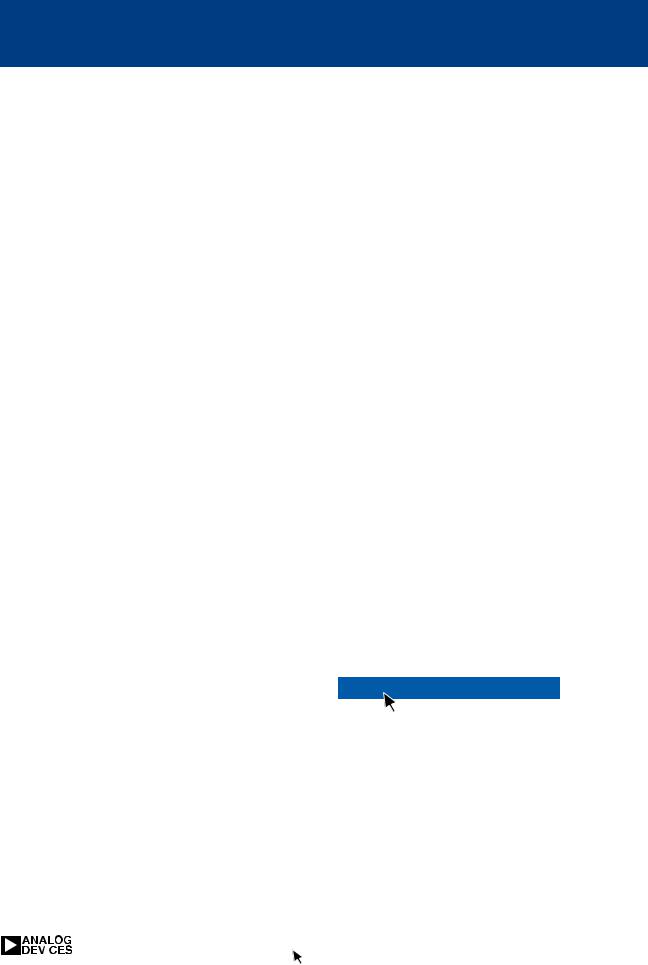
providing feedback to the user on latencies and stalls. Feedback is given as warnings and informational messages out of the assembler and in the assembler listing.
Linker & Loader
The linker provides flexible system definition through linker description files (.ldf). In a single .ldf file, users are able to define different types of executables for a single or multiprocessor system. The linker resolves symbols over multiple executables, maximizes memory use, and allows common code to be shared among multiple processors. The loader supports creation of host, link port, and PROM boot images. Along with the linker, the loader allows multiprocessor system configuration with smaller code and faster boot time.
Expert Linker
The “Expert” Linker creates a graphical utility that makes it easier for users to produce Linker Definition File (LDF) without having to learn the LDF syntax. The graphical representation of the commands in an LDF file also allows the engineer to manipulate the graphical representation for changes to the LDF or generation of an LDF file. The Expert Linker also allows users to optimize their placement of code.
Cache
The Blackfin DSP simulator collects cache statistics that are associated with both the PC/Source Line and the Cache Line/Set. Collectable statistics are; Total Cache Accesses, Cache Hits, and Cache Misses. There will be three types of displays: Histogram by PC/Source Line, Cache Line Display where hit/miss data is associated by Cache Line/Set(way), Summary Display of totals for hits/misses by cache.
VisualDSP++
Pipeline Viewer
The Pipeline Viewer is an ActiveX plug-in that allows a user to visually display the instruction flow through the sequencer's pipeline. Stalls, aborts and other pipeline events are graphically displayed. Visualization of the pipeline and of the pipeline events allows a user to better understand where and why latencies and stalls are being introduced into an executable. Armed with this knowledge the user can optimize an executable's instruction sequence to minimize the number of pipeline events.
The DSP Collaborative
The VisualDSP++ environment enables independent third party companies to add value using ADI’s published set of application programming interfaces (API’s). The DSP Collaborative is a comprehensive collection of DSP development support companies. The DSP Collaborative product offerings – real-time operating systems, emulators, high-level language compilers, and multiprocessor hardware
– can interface seamlessly with VisualDSP++ thereby simplifying development across all platforms and targets.
Ordering Information
Please call your local Analog Devices sales representative or distributor for pricing and ordering information. You may also visit the ADI web site and buy online at www.analog.com.
http://www.analog.com/dsp/tools
|
http://www.analog.com/dsp/tools |
DSP Selection Guide 13 |
|
|
|
|
|
|
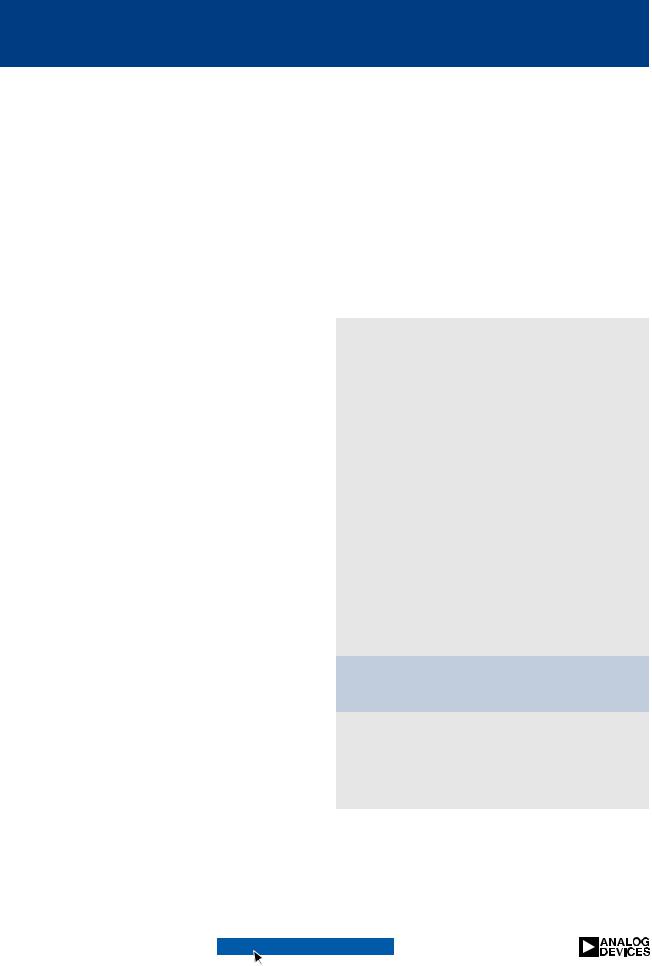
Development Tools
16-Bit DSP Family and Blackfin DSP Family
Development tools from Analog Devices are one of the industry's most complete lines, from the economical EZ-KIT Lite™ evaluation kits to an integrated development environment. These tools are easy to learn and easy to use, and allow designers to bring DSP-based products to market quickly and efficiently.
VisualDSP++ Integrated Development
Environment
VisualDSP++™ is a comprehensive toolset for Blackfin DSP, ADSP-218x and ADSP-219x DSPs. VisualDSP++ enables design engineers to easily develop, debug, and deploy code throughout the research, design, development, and test stages of any project. VisualDSP++ integrates all of the code generation tools below:
• Assembler |
• Math, DSP and |
• Linker |
C/C++ runtime library |
• Simulator |
• Integrated develoment |
• C/C++ compiler |
environment |
• Debugger |
• VisualDSP++ Kernel |
• PROM splitter |
• Statistical profiling |
• Graphical plotting |
• VisualDSP++ |
• Expert Linker |
Component Software |
|
Engineering |
(ADSP-218x does not have C++ support)
EZ-KIT Lite™ Evaluation Kit: The EZ-KIT Lite provides an easy way to evaluate the power of ADI’s DSPs and begin to develop applications. These systems consist of a standalone evaluation board and an evaluation suite of VisualDSP++ to facilitate architecture evaluations via a PC-hosted tool set. Restrictions: Software is limited for use with the EZ-KIT Lite and program memory is limited in size. With the EZ-KIT Lite users can:
•Evaluate ADI's DSPs
•Learn about DSP applications
•Simulate & debug applications
•Prototype applications
Emulators: Emulators provide non-intrusive target-based debugging of DSP systems. Compact and easy to use, these in-circuit emulators perform a wide range of emulation functions including single-step and full-speed execution with pre-defined breakpoints, viewing and/or altering of register and memory contents. A serial port emulator is available for the ADSP-218x DSP family and JTAG emulators are available for ADSP-219x DSPs and the Blackfin™ DSP family.
Model |
Supported DSP |
|
|
Evaluation Kits |
|
ADDS-2181-EZLITE |
ADSP-2100 Family |
|
ADSP-2181 |
|
|
ADDS-2189M-EZLITE |
ADSP-218x Family |
ADDS-2191-EZLITE |
ADSP-219x |
|
|
ADDS-21535-EZLITE |
Blackfin DSP |
Development Software |
|
VDSP-21XX-PC-FULL |
ADSP-21xx Family |
|
VisualDSP++ IDE, Debugger, |
|
Compiler, Assembler, Linker with |
|
Emulation and Simulation Support |
|
|
VDSP-21XX-PCFLOAT |
ADSP-21xx Family |
|
VisualDSP++ Floating License |
|
|
VDSP-21XX-PC-TEST |
ADSP-21xx Family |
|
VisualDSP++ Test Drive |
|
30-Day Free Trial |
|
|
VDSP-BLKFN-PC-FULL |
Blackfin DSP Family |
|
VisualDSP++ IDE, Debugger, |
|
Compiler, Assembler, Linker with |
|
Emulation and Simulation Support |
|
|
VDSP-BLKFN-PCFLOAT Blackfin DSP Family
VisualDSP++ Floating License
VDSP-BLKFN-PC-TEST Blackfin DSP Family
VisualDSP++ Test Drive
|
30-Day Free Trial |
|
|
Emulators |
|
ADDS-218X-ICE-2.5V |
ADSP-218xM/N Family |
ADDS-APEX-ICE |
ADSP-219x and |
|
Blackfin DSP USB-Based |
ADDS-SUMMIT-ICE |
ADSP-219x and |
|
Blackfin DSP PCI-Based |
14 DSP Selection Guide |
http://www.analog.com/dsp/tools |
|
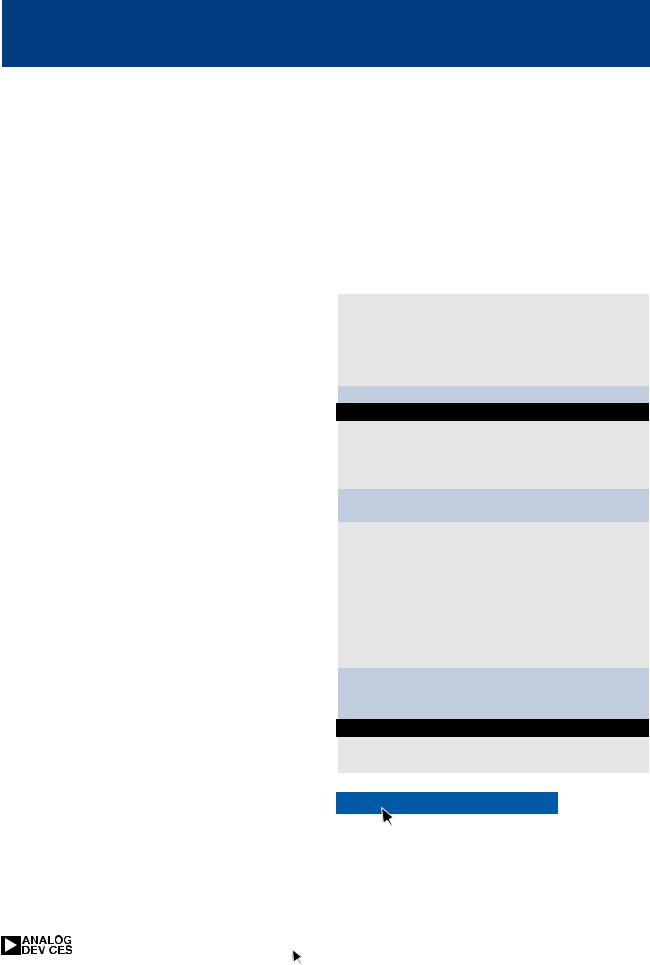
Development Tools
SHARC® and TigerSHARC® DSP Family
The 32-bit floating-point SHARC® DSP family of products offer the simplicity of floatingpoint mathematics coupled with high memory integration. With the highest level of floatingpoint performance, the TigerSHARC® DSP products offer the flexibility of 1, 8, 16 and 32bit fixed-point math in addition to floatingpoint arithmetic.
VisualDSP++ Integrated Development
Environment
VisualDSP++ is a comprehensive toolset for SHARC and TigerSHARC DSPs. VisualDSP++ enables design engineers to easily develop, debug, and deploy code throughout the research, design, development, and test stages of any project. VisualDSP++ integrates all of the code generation tools below:
• Assembler |
• Math, DSP and |
• Linker |
C/C++ runtime library |
• Simulator |
• Integrated develoment |
• C/C++ compiler |
environment |
• Debugger |
• VisualDSP++ Kernel |
• PROM splitter |
• Statistical profiling |
• Graphical plotting |
• VisualDSP++ |
• Expert Linker |
Component Software |
|
Engineering |
EZ-KIT Lite™ Evaluation Kit: The EZ-KIT Lite provides an easy way to evaluate the power of ADI’s DSPs and begin to develop applications. These systems consist of a standalone evaluation board and fundamental debugging software to facilitate architecture evaluations via a PC-hosted tool set. Restrictions: Software is limited for use with the EZ-KIT Lite and program memory is limited in size. With the EZ-KIT Lite users can:
•Evaluate ADI's DSPs
•Learn about DSP applications
•Simulate & debug applications
•Prototype applications
Emulators: Emulators provide non-intrusive target-based debugging of DSP systems. Compact and easy to use, these JTAG emulators perform a wide range of emulation functions including single-step and full-speed execution with pre-defined breakpoints, viewing and/or altering of register and memory contents. DSP emulators are available for PCI and USB host platforms.
|
Model |
Supported DSP |
|
|
|
|
Evaluation Kits |
|
|
ADDS-21061-EZLITE |
ADSP-2106x Family |
|
|
|
|
ADDS-21160-EZLITE |
ADSP-21160M |
|
ADDS-21160N-EZLITE |
ADSP-21160N |
|
|
|
|
ADDS-21161N-EZLITE |
ADSP-21161N |
|
ADDS-21065L-EZLITE |
ADSP-21065L |
|
ADDS-TS101S-EZLITE |
ADSP-TS101S |
Development Software
VDSP-SHARC-PC-FULL SHARC DSP Family
VisualDSP++ IDE, Debugger,
Compiler, Assembler, Linker with Emulation and Simulation Support
VDSP-SHARC-PCFLOAT SHARC DSP Family
VisualDSP++ Floating License
VDSP-SHARC-PC-TEST SHARC DSP Family
VisualDSP++ Test Drive
|
30-Day Free Trial |
VDSP-TS-PC-FULL |
TigerSHARC DSP Family |
|
VisualDSP++ IDE, Debugger, |
|
Compiler, Assembler, Linker with |
|
Emulation and Simulation |
|
Support |
VDSP-TS-PCFLOAT |
TigerSHARC DSP Family |
|
VisualDSP++ Floating License |
VDSP-TS-PC-TEST |
TigerSHARC DSP Family |
|
VisualDSP++ Test Drive |
|
30-Day Free Trial |
Emulators
ADDS-APEX-ICE USB-Based
ADDS-SUMMIT-ICE PCI-Based
http://www.analog.com/dsp/tools
|
http://www.analog.com/dsp/tools |
DSP Selection Guide 15 |
|
|
|
|
|
|
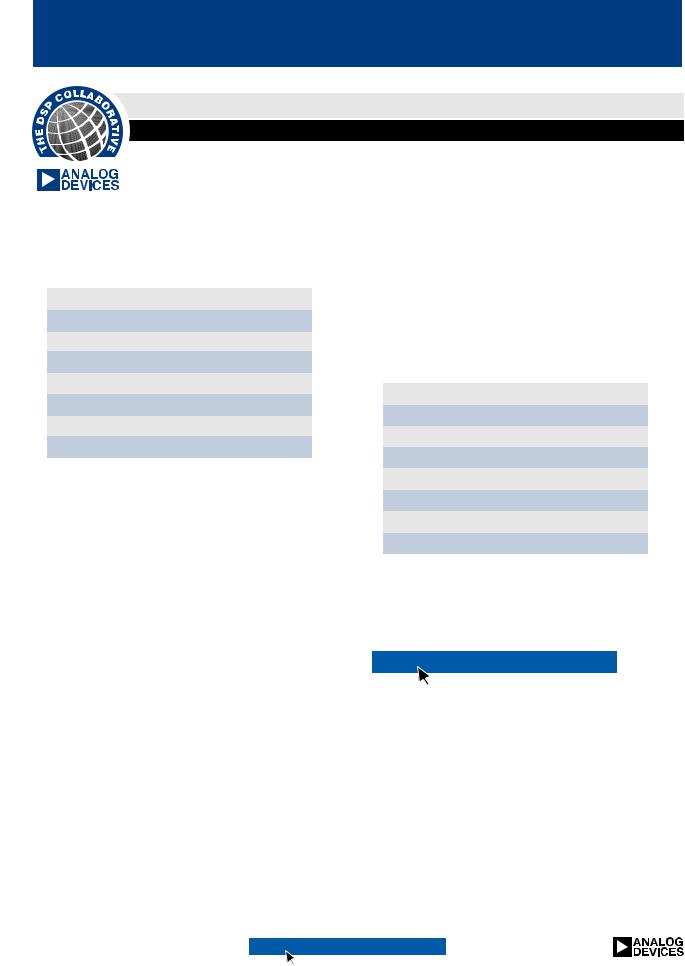
The DSP Collaborative
ADI’s Third Party Partner Network
Reach of the DSP Collaborative
The DSP Collaborative partners (Analog Devices’ Third Party Network) offer tools, services and solutions for a wide range of applications/markets:
Communications
Audio
Medical imaging
Speech processing
Motor control
Industrial automation
Optical networking
Voice over IP
When you select Analog Devices as your DSP vendor, you’re broadening your design team to include the industry-leading resources of the DSP Collaborative. The DSP Collaborative is comprised of over 180 partners who offer more than 700 commercial products, in addition to hundreds of custom solutions that build on more than 35 years of signal processing experience found in every one of our DSPs. These partners offer consulting services as well as a wide range of commercial off-the-shelf (COTS) products. Their development tools are specifically designed to work with Analog Devices’ DSP-based systems.
With the DSP Collaborative, you are supported by highly-reputable brands, patented technologies, and the pioneers in real-time system design and debug. The DSP Collaborative partners offer products and services that provide both system and application-level expertise.
Speed up your design process by leveraging the solutions our partners have to offer:
Algorithms and libraries
MATLAB® DSP support
Real-Time Operating Systems
Development and evaluation boards COTS hardware boards
DSP systems
Emulators
Debuggers
Design with Analog Devices’ DSP Collaborative team approach with a proven strategy for maximizing your resources!
http://www.analog.com/dsp/3rdparty
16 DSP Selection Guide |
http://www.analog.com/dsp/3rdparty |
|
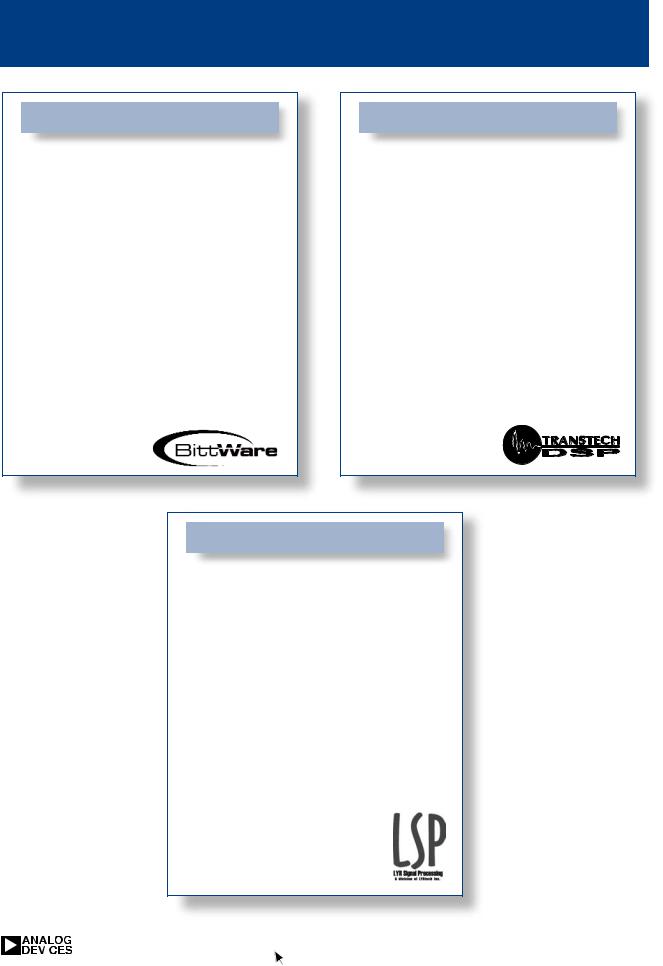
The DSP Collaborative
Key Partners
BittWare, Inc.
BittWare, Inc. is a leading supplier of SHARC-based hardware and software solutions, providingour clientswithinnovative off-the-shelf and applicationspecific solutions for their high-performance, realtime signal processing and I/O requirements. Based exclusively on Analog Devices' SHARC technology, BittWare’s product family includes innovative standard DSP boards and I/O peripherals on a variety of embedded platforms including PCI bus, CompactPCI,PC/104, PC/104-Plus, PMC, PMC+, andISA bus. Fromprototype to high-volumepro- duction, off-the-shelf products to application-specif- ic solutions, BittWare is the embedded SHARC DSP solutions provider.
http://www.bittware.com
Transtech DSP
Transtech DSP is a total solutions provider of high performance DSP equipment. Pioneers of multi-pro- cessing DSP systems formore than fourteen years, Transtech systems use a number of processors families, including the SHARC and TigerSHARC DSPs, and a choice of industry standard formats such as VME, PCI, PMC and CompactPCI. The company's extensive product line also includes I/O boards, software tools, libraries, drivers, and enclosures, to provide our customers with complete systems or custom designs. Transtech products are used to solve the most computer intensive of signal processing problems, which include radar, sonar, software radio, surveillance and medical imaging.
http://www.transtech-dsp.com
TM
LYRtech Signal Processing (LSP)
LYRtechSignalProcessing(LSP)providesengineers withcomplete,board-levelsolutionstotheirsignal processingneeds.Itoffersacomprehensivelineof mixedDSP/FPGAboardsthatresultinincreased performance,costeffectivenessandoverallefficiency ofdevelopedsystems.Simplifyingthedesigntask, LSPprovidesitsuserswithahigh-levelintegration withTheMathWorks'MATLAB/SIMULINKtools,as wellasXilinx'sSystemGenerator. The integration makesitpossibletorapidlyimplementdesigns,but lateralsoperformsoftwareoptimizationthroughlowlevelschemes(embeddedJTAG,optimizedlibraries, profilers, etc.).Completingtheline,LSPprovidescustomerswithcomprehensiveconsulting
andsupportpackagesinthefieldsof telecommunicationsandmultimedia.
http://www.signal-lsp.com
|
http://www.analog.com/dsp/3rdparty |
DSP Selection Guide 17 |
|
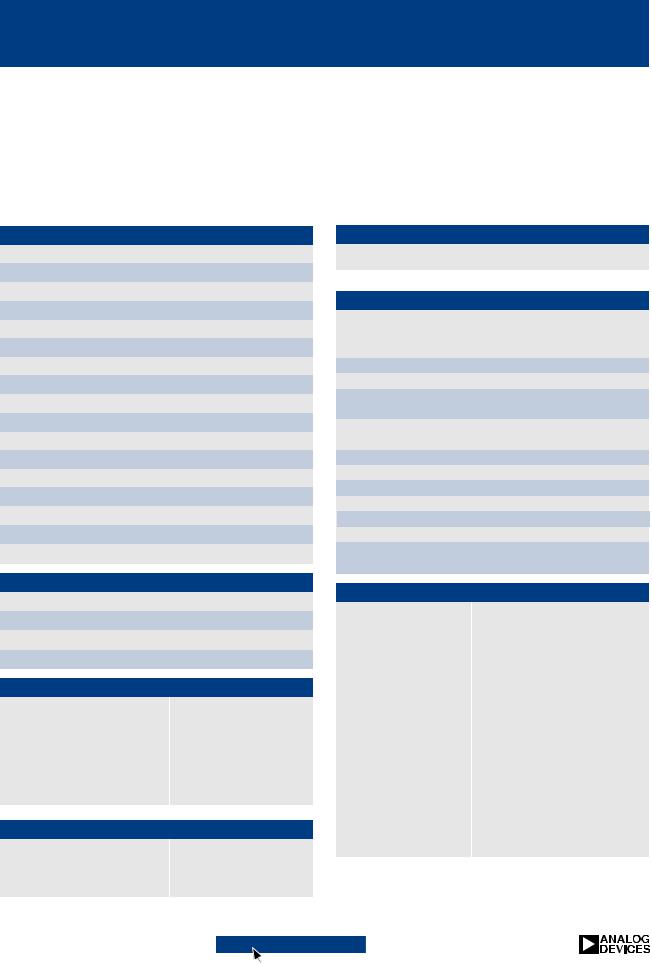
SPA DSP Software Algorithms
Analog Devices SPA Technology Centre (formerly Signal Processing Associates) is recognized worldwide for providing expertise in DSP solutions for the telecommunications and multimedia industry since 1987. The SPA product range consists of a broad portfolio of DSP software algorithms including speech compression, echo cancellation, fax and data modem-pumps, error correction and numerous other telephony code modules. Typical product application areas are listed below. The SPA Technology Centre is renowned for excellent customer support, product documentation and APIs that allow rapid integration of the code into customer’s new product designs.
Audio/Speech Software Algorithms
G.723.1 (5.3/6.3 kbit/s)
G.723.1A (5.3/6.3 kbit/s)
G.729 (8 kbit/s)
G.729A (8 kbit/s)
G.729B (8 kbit/s)
G.729AB (8 kbit/s)
G.728 (16 kbit/s)
G.726 (40/32/24/16 kbit/s)
G.727 (40/32/24/16 kbit/s)
G.722 (64/56/48 kbit/s)
G.711 (64 kbit/s)
Variable Rate Coders
H.32x Audio Modules
Voice Activity Detectors (VAD)
Voice AGC (Variable response time)
Comfort Noise Generator (CNG)
End to End Synchronization
Echo Cancellation Software Algorithms
G.168 Line Echo Canceller (LEC)
G.165 Line Echo Cancellation (LEC)
Acoustic Echo Cancellation (AEC – variable span) Acoustic Echo Suppression (AES)
Data Modem Software Algorithms
V.33 |
(14,400 bps 4-wire) |
V.22 |
(1,200 bps) |
V.32bis (14,400 bps) |
V.23 |
(1,200/75 bps) |
|
V.32 |
(9,600 bps) |
Bell 212A (1,200 bps) |
|
|
|
|
|
V.29 |
(9,600 bps 4-wire) |
Bell 103 (300 bps) |
|
V.22bis (2,400 bps) |
V.21 |
(300 bps) |
|
V.27ter (4,800 bps 4-wire) |
|
|
|
Facsimile Modem Software Algorithms |
|||
V.17 |
(14,400 bps) |
V.27ter (4,800 bps) |
|
|
|
|
|
V.33 |
(14,400 bps) |
V.21 |
(300 bps) |
V.29 |
(9,600 bps) |
|
|
Forward Error Correction (FEC) Software Algorithms
Viterbi / Trellis |
Interleavers |
|
|
Reed Solomon |
|
Telephony Software Algorithms
Relay (4-64 kbit/s transmission of voice/fax/data over internet, satellite, radio, microwave, ISDN, LAN, ATM & other packet networks)
Internet Audio
Speakerphone
DTMF Detector (high performance & Bellcore, EIA, ETSI, Telstra compliant)
DTMF Encoder (high performance & ITU, Bellcore, EIA, ETSI, Telstra compliant)
Call Progress
Caller ID
RTP/JIB (Jitter Buffer)
Ring Detector
E & M Signalling
Tone Detection System (TDS)
Gaussian Noise Source (GNS) Ultra-high quality wideband gaussian noise generator
Product Application Areas
Internet Telephony |
H.324 |
|
|
VoN |
H.323 |
VoIP |
H.320 |
|
|
VoDSL |
Audioconferencing |
VoATM |
Videophones/Feature-phones |
|
|
VoCable |
Digital Voice Storage |
FoN |
Frame Relay |
|
|
FoIP |
PBX Equipment |
TRAU/Transcoders |
RAS |
|
|
Basestations |
DSVD |
Wireless/Mobile |
DCME |
|
|
Gateways |
ISDN |
CPE/IADs/SOHO/CO |
Rural Radio Networks |
|
|
IP Phones |
Satellite/Microwave Systems |
|
|
18 DSP Selection Guide
http://www..anallog..com/spadsp

SPA DSP Software Algorithms
|
|
Description |
Peak |
Average |
PM |
DM |
PM+ |
DM+ |
|
||
|
|
MIPS |
MIPS |
(Words) |
(Words) |
(Words) |
(Words) |
|
|||
Vocoders |
|
|
|
|
|
|
|
|
|
|
|
|
|
|
|
|
|
|
|
|
|||
G.723.1 |
5.3 kbit/s |
18.4 |
16.9 |
9558 |
11679 |
0 |
951 |
|
|||
G.723.1 |
6.3 kbit/s |
18.9 |
17.6 |
9558 |
11679 |
0 |
951 |
|
|||
G.723.1A |
5.3 kbit/s + VAD/CNG |
18.6 |
17 |
9558 |
11679 |
0 |
951 |
|
|||
G.723.1A |
6.3 kbit/s + VAD/CNG |
19.1 |
17.6 |
9558 |
11679 |
0 |
951 |
|
|||
G.729 |
8 kbit/s |
19.9 |
18.9 |
8844 |
4634 |
0 |
1432 |
|
|||
G.729A |
8 kbit/s (low MIPS) |
10.8 |
10.4 |
7932 |
4677 |
0 |
1532 |
|
|||
G.729B |
8 kbit/s + VAD/CNG |
20.1 |
19.3 |
12064 |
5405 |
0 |
1603 |
|
|||
G.729AB |
8 kbit/s (low MIPS + |
12.7 |
10.8 |
11900 |
7700 |
0 |
1821 |
|
|||
|
|
VAD/CNG) |
|
|
|
|
|
|
|
|
|
G.728 |
16 kbit/s |
29 |
27 |
7947 |
2272 |
930 |
1743 |
|
|||
G.726 |
40/32/24/16 kbit/s |
8.5 |
8 |
1466 |
240 |
47 |
100 |
|
|||
G.727 |
40/32/24/16 kbit/s |
9.9 |
N/A |
1262 |
252 |
|
|
|
|||
G.722 |
64/56/48 kbit/s |
12.9 |
N/A |
1458 |
217 |
|
|
|
|||
G.711 |
64 kbit/s |
0.4 |
0.4 |
111 |
6 |
0 |
0 |
|
|||
G.711 (II) |
64 kbit/s + adaptive CNG |
1 |
N/A |
2011 |
1700 |
0 |
50 |
|
|||
|
|
|
|
|
|
|
|
|
|
||
Echo Cancellation |
|
|
|
|
|
|
|
|
|
||
G.165/G.168 |
16 msec, ECD On |
6.6/7.03 |
N/A |
1100/1211 |
354/412 |
276 |
340 |
|
|||
G.165/G.168 |
16 msec, ECD Off |
4.5/4.97 |
N/A |
1100/1211 |
354/412 |
276 |
340 |
|
|||
G.165/G.168 |
32 msec, ECD On |
9.2/10.6 |
N/A |
1100/1211 |
354/412 |
276 |
340 |
|
|||
G.165/G.168 |
32 msec, ECD Off |
7.1/8.57 |
N/A |
1100/1211 |
354/412 |
276 |
340 |
|
|||
G.168 |
64 msec |
15 |
N/A |
1000 |
124 |
0 |
1700 |
|
|||
G.168 |
128 msec (sparse) |
|
N/A |
|
|
|
|
|
|
||
AEC |
Acoustic Echo Canceller |
5.2 |
N/A |
3153 |
3059 |
|
|
|
|||
64 msec span |
|
|
|
|
|
|
|
|
|
|
|
AEC |
Acoustic Echo Canceller |
7.2 |
N/A |
3153 |
3059 |
|
|
|
|||
128 msec span |
|
|
|
|
|
|
|
|
|
|
|
AEC |
Acoustic Echo Canceller |
11.2 |
N/A |
3153 |
3059 |
|
|
|
|||
256 msec span |
|
|
|
|
|
|
|
|
|
|
|
AEC |
Acoustic Echo Canceller |
15.2 |
N/A |
3153 |
3059 |
|
|
|
|||
384 msec span |
|
|
|
|
|
|
|
|
|
|
|
|
|
|
|
|
|
|
|
|
|
|
|
Telephony |
|
|
|
|
|
|
|
|
|
|
|
DTMF |
Encoder |
0.5 |
N/A |
68 |
|
78 |
2 |
0 |
|
||
DTMF |
Decoder |
1 |
N/A |
1300 |
320 |
0 |
256 |
|
|||
Caller ID |
*Bellcore (I & II) |
1.8 |
N/A |
939 |
53 |
0 |
180 |
|
|||
Call Progress |
*Tone Generation |
0.5 |
N/A |
70 |
|
80 |
4 |
2 |
|
||
TDS |
*Tone Detection System |
2.5 |
N/A |
1207 |
641 |
|
|
|
|||
VAD |
Voice Activity Detection |
0.2-2.0 |
N/A |
515 |
166 |
0 |
123 |
|
|||
CNG |
Comfort Noise Generation |
1 |
N/A |
2011 |
1700 |
0 |
50 |
|
|||
|
|
|
|
||||||||
This table presents only a selection of SPA’s most popular ADSP-218x and ADSP-219x based code modules. |
|
|
|
||||||||
Please contact SPA or refer to the SPA web site (www.analog.com/spa) for a full list of available algorithms. |
|
|
|
||||||||
Not currently multiple instance Contact SPA for figures |
* Other Standards on request |
|
|
|
|||||||
|
|
|
|
|
DSP Selection Guide 19 |
||||||
|
|
|
|
http://www.analog.com/spa |
|
||||||
|
|
|
|
|
|||||||
